by Ingo Arndt, Claus-Peter Lieckfeld and Peter Huemer
Papadakis Publisher, London
ISBN 978-1901092-92-9
£20
www.papadakis.net
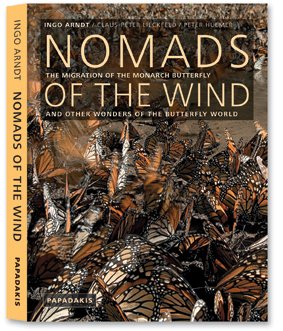 |
Perhaps the most incredible feat of all is the 2,000 mile migration of the Monarch butterfly. Once a year millions of a special long-living generation of Monarchs migrate from the north-eastern United States and southern Canada to the Oyamel fir forests of Mexico, where they survive the winter. But then, as soon as they feel the first warmth of spring they all set out on the return journey through the Rio Grande and Texas, procreating on the way, until the second and third generations arrive back at the Great Lakes to start the cycle all over again.
Award-winning nature photographer Ingo Arndt has followed them on their journey while the accompanying informative text by Claus-Peter Lieckfeld and Peter Huemer explains the latest research on the migration and describes in detail the transformation from caterpillar to magnificently coloured butterfly.
But this is not the only wonder in the world of butterflies, a world full of surprises. There are butterflies that are masters of disguise and others that are imposters or that mimic their poisonous relatives to protect themselves from predators. Ingo Arndt has photographed them all and in so doing has created a beautiful record of the butterflies themselves, their existence, habits and life cycle. A fitting tribute to this extraordinary species that lights up our lives.
Ingo Arndt is one of the world's most highly acclaimed nature photographers. His award-winning photographs have been published in GEO, National Geographic, nature+kosmos, and BBC Wildlife. Reporting assignments have taken him to every continent, where he has photo-graphed animals and their habitats in unparalleled detail. His numerous awards include the World Press Photo Award (2005), the German Prize for Science Photography (2006), and several awards in the BBC Wildlife Photographer of the Year competition. His other photographic books include Monkeys and Apes in the Wild, published by Papadakis in 2008.
Claus-Peter Lieckfeld was a founding member and editor the German ecological magazine natur and is now a freelance author. His articles on nature and animals have appeared in many journals such as GEO, Die Zeit, Merian, and SZ-Magazin. He has also written the text for several important illustrated books on the natural world, including Africa and polar bears.
Peter Huemer studied biology, earth sciences, zoology and botany at the University of Innsbruck, where he is now a lecturer; he is also attached to the Natural Science Collection of the Tyrolean State Museum as a biologist. A recognized butterfly expert, he has described more than 60 new butterfly species as well as contributing to more than two hundred articles and books.
One of the most well-known butterfly spectacles is the annual migration of the Monarch butterfly from North America through to its overwintering sites in Mexico. However, I have to say that this book provides the most complete coverage of this event that I've read, and does so in conjunction with some superb photography from award-winning Ingo Arndt. As such, this book will appeal to both those wanting an informative read, and also photographers needing inspiration!
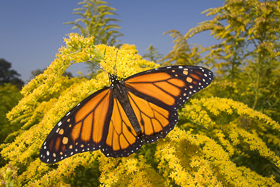 |
| Image © Ingo Arndt |
The majority of the book (115 of the 192 pages) is dedicated to the migration of the Monarch butterfly. The book traces the story of "GJE 148" - a Monarch butterfly that has been tagged as part of a research project by the University of Kansas, in order to trace her migration south. The book interweaves the story of "148" with factual information about her journey, and the subsequent lifecycle that one of her offspring, "148a", follows, and the return journey.
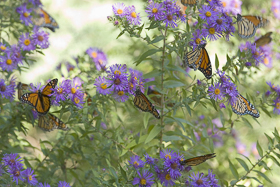 |
| Image © Ingo Arndt |
The book makes relevant diversions where appropriate, touching on defence strategies (including warning signs, development of toxins and mimicry), historical references to migration (some dating from the year 1100), nectar sources, butterfly fossils (that are 48 million years old!), other migrating Lepidoptera (such as the Painted Lady, Convolvulus Hawk-moth and Hummingbird Hawk-moth), parasites (such as Ichneumonid wasps), ultraviolet light reception, the significance of sun and magnetic field in providing directional guidance, the development of the proboscis, mating habits, the transformation from egg to adult, the effects of climate change, and so on. Clearly, given this list, this book is much more than a collection of excellent photos.
The book also makes sure that the very realistic challenges of logging and deforestation are discussed, and the impact that such activities have on overwintering Monarchs. The sensitivity that Monarchs have to any ensuing cold snaps is discussed, with many thousands of butterflies sometimes perishing, given the cooler conditions in their less-protective shelter. There is also a brief mention of some of the efforts to protect the overwintering grounds.
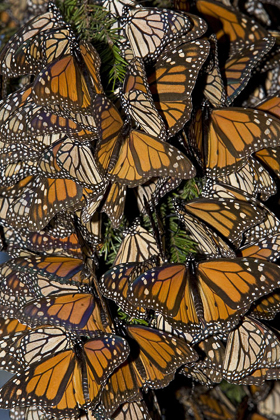 |
| Image © Ingo Arndt |
The photography that accompanies the text is both diverse and inspiring. There are photos that would appeal to those interested in "super-macro" photography, all the way through to spectacular landscape shots - some taken from the air. And everything in-between. The quality of the photos has to be seen to be believed. But looking at a shot of a Monarch where every scale on the wings is clearly visible and pin sharp is something that most photographers can only aspire to.
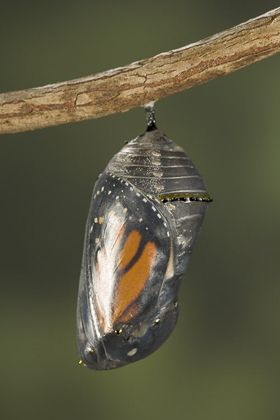 |
| Image © Ingo Arndt |
One question that the book acknowledges as remaining unanswered, is how the Monarch "knows" that it must fly south. Or how the offspring "know" that they must fly north. In a way, I'm glad that such basic questions remain unananswered, since this would surely diminish the mystery that surrounds the Monarch butterfly.
Although this book is focused primarily on the Monarch butterfly, the "Other Wonders of the Butterfly World", that are hinted at in the book's subtitle, represent the second part of the book. This part contains superb photos of a variety of species (including moths) through all stages of the lifecycle - ovum (egg), larva (caterpillar), pupa (chrysalis) and imago (adult). Again, the photographs are superb with an excellent level of detail even for the tiniest of subjects - such as a series of photos showing larval emergence from the egg. The photos and associated discussion are grouped around various themes, and represent a complementary collection of notes and photos that add to the story of the Monarch.
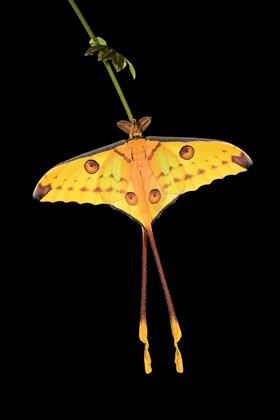 |
| Image © Ingo Arndt |
The only negative comment I have is that, given the excellent photos included in the book, it would have been nice to have seen the settings that Ingo had used to take his photos, and the equipment used. But since this isn't a book about photography, perhaps I shouldn't be surprised! I just want to be able to take photos like his!
In summary, this book is both informative and visually stunning. It will appeal to those wanting to read, in detail, the story of the migration of the Monarch, through to photographers wanting inspiration, through to casual readers who simply want a companion while they drink their coffee! Meeting the demands of such a broad readership is a rare combination indeed. As such, I highly recommend this book.